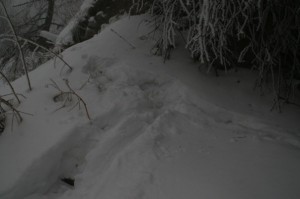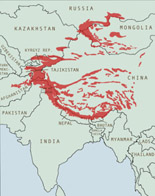
Snow leopard scrapes found by the W.A.N.T expedition to Tian Shan Mountains in Kygyzstan in January 2010. Photo W.A.N.T
Wildlife & Nature Travel is a conservation-oriented travel company that ran a Snow Leopard expedition to the Tian Shan Mountains in Kyrgyzstan in January 2010. Struggling through a cold snowy winter environment shows the dedication of the team members, keen for sightings of the endangered cat still living in this region. The team found scrapes and pug marks and two people were lucky enough to catch a glimpse of the cat that had been heard the night before with its cub.
Jessica Pociask, who runs the company with her husband Akos Hivekovics wrote this story about the Snow Leopard Trek for our website.
Jessica – “Kyrgyzstan declared its independence from the Soviet Union in 1991; its troubles, however, were far from over. A land locked country, with fertile volcanic soils, rich mineral deposits, and oppressed native peoples, made Kyrgyzstan ripe for escalating corruption and exploitation over the years.
When I last checked, with “0” being the worst and “10” being the best, Kyrgyzstan ranked at a whopping 1.9 on the Corruption Perceptions Index. As a tour company specializing in expeditions to see the most amazing natural phenomena that exist on our planet, Wildlife and Nature Travel often works in undeveloped countries with lagging infrastructure, which can make it challenging to arrange tours in advance due to political or economical instability. Fortunately, as in most cases, we had an excellent person on the ground that had been living in the country since 1993, and knew how to navigate the system, and get us to where we were going.

Spectacular Tian Shan Mountains, still home to some endangered snow leopards. Photo by W.A.N.T snow leopard expedition, January 2010.
So why go to Kyrgyzstan for snow leopards you might ask? Perhaps the one saving grace stemming the tide of environmental exploitation and destruction, and providing desperately needed refuge for this incredible animal, is a single, but significant, geological feature -the Tien Shan Mountains. This mountain range covers 80% of Kyrgyzstan, and make it virtually impenetrable.
Our mountain camp was located within the boundaries of a hunting preserve and we only reached it, in the heart of snow leopard territory, by way of hiking several miles up alongside a frozen river. It was a daunting task that required several additional trips by our diligent porters to haul and set up camp. Excitingly, once we arrived, it became apparent that there were at least two snow leopards currently in the area.
We immediately set out in search of the snow leopards, and over a period of six days, we were teased and tormented by scat on the trails, scent markings, scrapes and tracks crossing every which way. In the night, up the steep sides of the valley, we were pulled from our icy slumber by the meowing of a kitten and the deep rumbling, reassuring voice of its mother.

Challenging cold and snow in snow leopard country, Tian Shan Mountains, Kyrgyzstan. W.A.N.T snow leopard expedition. Photo Uwe Haller.
A big part of getting to see a snow leopard in its natural environment is simply experiencing how it survives in such harsh conditions. We searched high and low, scanning deep into the trees and amongst the rocks hoping for a glimpse of what is considered to be the world’s most elusive mammal and its prey, such as Argali Sheep, which was strangely absent, until finally our chance came on a blustery gray day. As we approached the rim of a canyon, someone scanned downward just in time to catch a snow leopard dashing away and into the trees! Its tracks confirmed the sighting, and the expedition was considered a success.
We remained in at our mountain camp for several more days, and although we had no more snow leopards sightings, the thing that struck me the oddest, was the lack of additional wildlife. Argali Sheep, protected by several governments, and listed as near threatened, is the main prey of snow leopards, but no matter how great their habitat may be, if their prey numbers drop, so does the number of snow leopards.
Unfortunately, we learned from the locals, Argali are regularly poached by trophy hunters for a mere $25,000, but the average annual salary in Kyrgyzstan is less than $500 a year, making it easy to see a frightening correlation between commodity and desperation that is probably fueling the decline of local wildlife and the ever ranging Snow Leopard.
Poaching of snow leopards is also a very real and serious threat. The recent capture, and extremely saddening death of a cat in Afghanistan is a testament to the demand this animal still commands on the black market. A quick visit to the zoo in Tamga, also presented an excellent view of how wildlife is valued in this country. Tiny, poor, filthy and degrading housings that could only be described as squalor enclosed some of the most incredible specimens in this region, including lynx, Przewalski horses, black fox and more. So while there is much more to comment on about the broken state of the country, and the risk its wildlife faces, it is more important than ever to continue to bring international attention to Kyrgyzstan to help its people to improve and develop its broken economy.
As an individual, your consumer choices can have a huge influence on their economy. The Snow Leopard Trust offers a number of high quality, handmade, beautiful, felted Kyrgyzstan handicrafts such as slippers and rugs, and the proceeds of which go to protect snow leopards and improve the lives of impoverished families. Your travel choices have an impact too. By traveling to this region to see snow leopards, you are leading by example and generating value for wildlife in the Kyrgyz culture. And, if the Kyrgyz people not only see enough tourists coming through, but the trickle down of the dollars associated with it, they’ll be more likely to protect and stand up for the conservation of wildlife and surrounding habitats. Poaching practices will also drop and wildlife protection will increase.
Finally, help to spread the word; you read this article, now pass it along to a friend. Knowledge is power. For more on this expedition, or to contact the author, Jessica Pociask, go to Wildlife and Nature Travel website. ”
Thanks Jessica, for this story on an exciting expedition which helps to protect remaining snow leopards in remote Kyrgyzstan.





